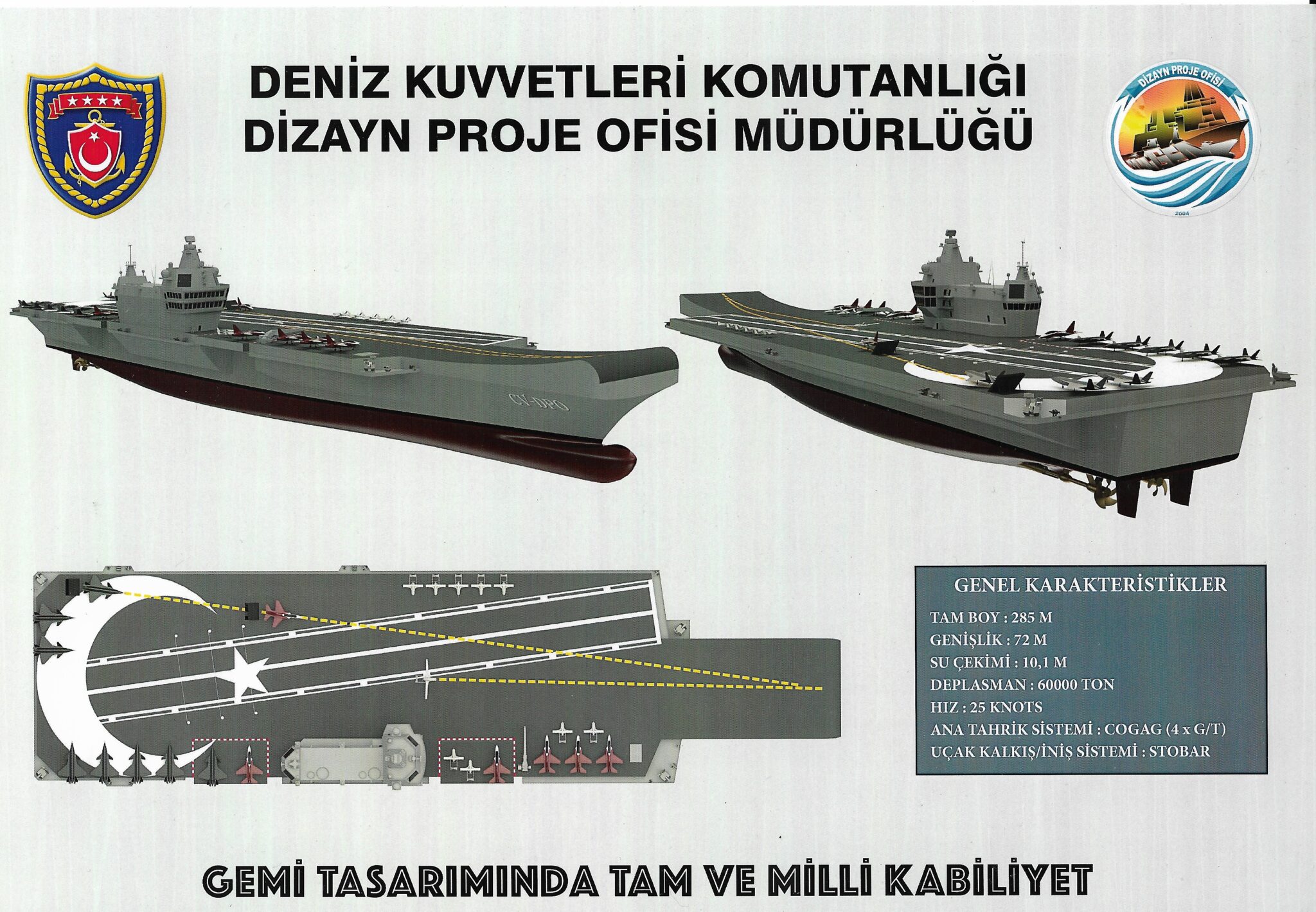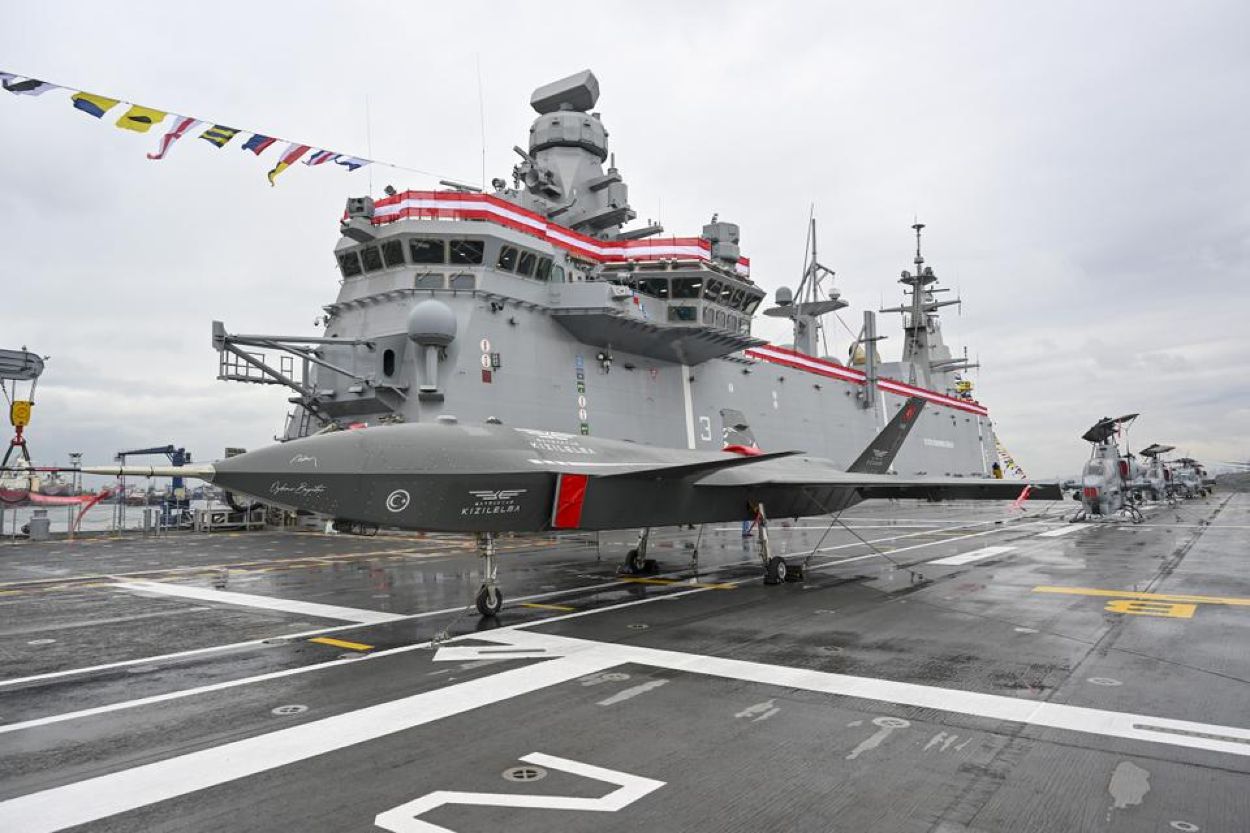Surpassing the size and role of its present aircraft carrier, the TCG Anadolu, Turkey has begun work on its second such warship.
According to media reports from Turkey, Istanbul Shipyard Command said that “both manned and unmanned aerial vehicles (UAVs) of domestic origin will be deployed on the new aircraft carrier.”
New Carrier Design
Reports quoted officials from the Directorate of Design Project Office (DDPO) of the Turkish Naval Command as saying the new carrier will be 285 meters in length with 60,000 tons of displacement. It will have Combined Gas Turbine and Gas Turbine (COGAG) propulsion to provide an uninterrupted maximum speed of 25 knots.
The DDPO is considering four LM2500 gas turbine engines, which also power the MİLGEM warships (the National Ship Project, a national warship program of the Republic of Turkey) and DİMDEG logistic support ships (Denizde İkmal Muharebe Destek Gemisi meaning Replenishment at Sea and Combat Support Ship) with onboard maintenance capabilities. “Work on the design for the propulsion system is ongoing,” a report on TurDef said.
Officially released images of the carrier showed a Short Take-Off Barrier-Arrested (STOBAR), which means planes and drones would have to take off on their power. This limits the amount of payload a single aircraft can carry.

Steam or electromagnetic-powered catapults and launch systems (CATOBAR or EMALS), on the contrary, can release planes with higher payloads.
However, Turkish engineers plan to develop an indigenous catapult system to eventually replace the modular ramp. The aircraft carrier is set to include three runways, with two designated for takeoff and one for landing.
The initial plan outlines the deployment of 50 aircraft, with 20 stationed on the deck and 30 housed in the hangar. The carrier will also be armed with a 32-cell MIDLAS VLS (Vertical Launching System) and four Gökdeniz Close-in Weapon systems for self-defense.
The computer-generated illustration showed aerial platforms like the Kizilelma unmanned combat aerial vehicle (UCAV), ANKA-3, TB-3 drones, and HÜRJET Light Combat Aircraft (LCA). It is not clear if the Turkish wishes to have a naval version of the indigenously-developed KAAN fifth-generation fighter.
Current Aircraft Carrier
Until the planned carrier is built and inducted, the largest warship in the Turkish navy fleet is another aircraft carrier, the TCG Anadolu, a “multipurpose amphibious assault ship.” The Anadolu would also be the world’s first vessel with an air wing mainly consisting of unmanned aircraft.
Based on Spain’s flagship, the Juan Carlos I, the TCG Anadolu is a landing helicopter dock (LHD) type amphibious assault ship. It is 231 meters (758 feet) long, 32 meters wide with a displacement of 27,436 tons. It has a top speed of around 21 knots, a range of 9,000 nautical miles, and can operate at sea for 50 days.

The ship was ordered in 2015, laid down in February 2018, launched in April 2019, and commissioned in April 2023. The Anadolu intended to undertake “sustaining long-endurance, long-distance military combat, or humanitarian relief operations while acting as a command center and flagship for the Turkish Navy.”
The ship’s air wing is expected to consist mostly of Bayraktar TB3s, a short-runway-capable version of the renowned Bayraktar TB2, both developed by leading Turkish drone major Baykar. The Kizilelma, another one of Baykar’s unmanned combat aerial vehicles (UCAV) — or the “unmanned fighter jet as Turkey describes it — is also being prepared to operate from the carrier.
After completing its maiden flight in December last year, the Kizilelma is being prepared for naval use with folding wings, and it is expected to be a “reconnaissance and missile-carrying platform.”
The description suggests a loyal wingman role for manned-unmanned teaming, which performs an extended surveillance, sensor, scanning, and weapons release platform. This eases many of the routine combat and aerial tactical functions of the manned combat jet while, in many situations, keeping it out of harm’s way.
Turkey’s Rising Defense Prowess
Ankara is continuing its trend of significant strides in its domestic defense industrial base by manufacturing its fifth-generation stealth fighter, the KAAN, which is expected to enter mass production in the late 2020s.
It has also emerged as a significant drone power with the development of unmanned combat aerial vehicles (UCAV) like the Bayraktar TB-2, TB-3, Anka, Anka-3, the Kizilelma loyal wingman UCAV, and a diverse range of air-to-air, air-to-land, land-attack ballistic, cruise and surface-to-air missiles.
These are developed by domestic defense aerospace companies like Baykar, Aselsan, Roketsan, and Tubitak-Sage. For instance, the under-development Siper SAM platform has been touted as a weapon comparable to the S-400. Aselsan CEO Haluk Gorgun had claimed that Turkey would “no longer need” the S-400 after the Siper becomes operational.
- The author can be reached at satamp@gmail.com
- Follow EurAsian Times on Google News




